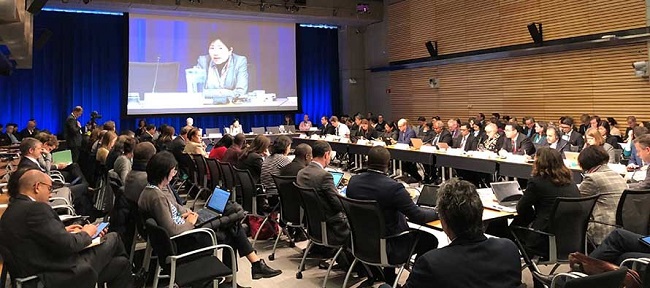On the agenda of the Global Environment Facility (GEF) Council, which opened on Tuesday, December 18, 2018 in Washington DC, are the first projects to be funded under its new, four-year investment cycle, known as GEF-7, and measures to further improve the GEF’s efficiency,accountability, transparency and environmental and social safeguards.

The 55th GEF Council meeting is the first to beheld since the conclusion of the GEF-7 negotiations earlier this year at the GEF Assembly in Da Nang, Viet Nam, which endorsed the new GEF-7 strategy, and $4.1 billion replenishment by governments of the GEF’s trust fund.
In her opening remarks to the Council, GEF CEO and Chairperson, Naoko Ishii, reflected on what has happened since Da Nang. “During the past few months, more and more evidence has been put forward that we are not winning the war on global environmental degradation,” she said. “In some aspects, we are even going backward.”
Highlighting a series of recent scientific reports – from “Hothouse Earth” to the WWF’s Living Planet Index and the IPCC 1.5 degree report, she stressed “the urgency of the situation we are in.”
“There is a need for urgent action to respond to those increasing challenges,” Ishii continued while reflecting on how recent international negotiations dealing with biodiversity (CBD COP14), mercury (Minamata COP2) and climate (UNFCCC COP24) all focused on accelerating action.
Commenting on GEF’s role, she said “GEF-7 is a powerful instrument for us, the GEF, to take our part in fighting the war against climate change and global environmental degradation.”
“Science tells us that we need transformational change in key systems,” she said. “GEF-7 programming strategies are designed to help catalyse transformational changes to food and land use systems,sustainable cities, and push the energy transition, while protecting key biomes.”
“In doing so, we emphasise the importance of involving key actors, not only national governments, but cities, private sector, CSOs and communities,” she said.
Noting GEF-7’s “very ambitious goal”, Ishii said that “for us to achieve it, we need to firm up our implementation policies and procedures. There is lots of room for tightening up our project preparation and execution so that we can deliver the results soonest.”
The 55th GEF Council, which ends December 20, will consider proposed new policy measures to speed up the preparation, endorsement, and implementation.
It will also have before it a proposed policy with new requirements for documenting and reporting on environmental and social risks,and potential impacts – and their management – throughout the GEF project and programme cycle, while also strengthening protections for indigenous peoples.
Even though the GEF already performs well on transparency and access to information, another new proposed policy would clarify its procedures and practices in this area.
The Council will also have before it a report showing that89 per cent of the GEF’s active projects that provided performance ratings were rated moderately satisfactory or higher for progress towards development objectives, and 83 per cent reached the same standard for progress in implementation.
The initial 18 GEF-7 projects before the Council would place13.8 million hectares of land and sea under protection or improved conservation of biodiversity, restore 300,000 hectares of degraded land, avoid the release of the equivalent of 23.1 million metric tons of carbon dioxide to the atmosphere and reduce, and/or dispose of, 7,100 metric tons of toxic chemicals.
The total GEF expenditure of $157.8 million is expected to attract an indicative $819.7 million in co-financing from other sources and, in all, 25 recipient countries will benefit from this work programme. A $64million grant to the GEF Small Grants Programme will benefit 107 countries with community-level work.
